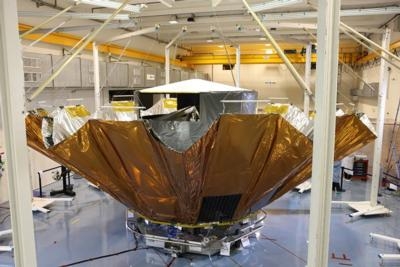Mon, Oct 14, 2013
Surveyor Will Be First Deep-Space Probe Boosted Aboard An Arianespace Soyuz Rocket
Payload preparations for Arianespace’s next Soyuz launch are progressing well at the Spaceport in French Guiana, where the Gaia billion-star surveyor is receiving its sunshield for in-orbit telescope protection as well as power generation. This sunshield is one of the final elements in completing the European Space Agency’s Gaia, the installation of which has been performed by the assembly, integration and testing team of prime contractor Astrium – with support from Spain’s SENER, which produced the sunshield.

The latest activities involved placement of the inner thermal blankets for Gaia’s multi-layer sunshield insulation, as well as incorporation of solar array panels that will provide energy to power all on-board electronics. Both elements are positioned on the sunshield’s carbon-fiber reinforced composite framework, which also was integrated at the Spaceport.
When the sunshield’s 12 folding frames are opened in orbit after launch by Arianespace’s Soyuz, the fully-insulated sunshield will form a flat disc at the base of Gaia – shading its telescope from the sun and maintaining the spacecraft’s scientific instruments at a constant temperature of approximately -100 degrees Celsius. This will allow Gaia to perform its ambitious mission of making the largest, most precise three-dimensional map of the Milky Way by surveying an unprecedented one percent of its 100 billion stars.
The solar array panels fixed to the sunshield will provide approximately 1,850 Watts of electrical power, to be used by Gaia for powering the data processing computers, along with the communications, navigation and thermal control systems. A massive amount of data will be collected over Gaia’s planned five-year mission, with its full archive to exceed 1 petabyte in size – providing enough information to answer questions related to the origin, structure and evolutionary history of the galaxy.

Gaia will be orbited on Arianespace’s Flight VS06, which is scheduled for liftoff on November 20 from the Spaceport. As indicated by the company’s launcher family numbering designation, this will be the Spaceport’s sixth liftoff with medium-lift vehicle since its introduction at French Guiana in October 2011 by Arianespace.
After being deployed by Soyuz, the hexagonal/conical-shaped spacecraft will follow a flight path to an orbit around the Sun at the second Lagrange point (L2) – a distance of about 1 million miles from Earth. This makes Gaia the first deep space payload launched by Arianespace with Soyuz from the Spaceport.
(Images provided by Arianespace)
More News
Aviation Governance Secured...At Least For a While The National Business Aviation Association similarly applauded the passage of the FAA's recent reauthorization, contentedly recou>[...]
Emphasis On Growing The Future of Aviation Through Concentration on 'AFFORDABLE FLYERS' It's been a number of years since the Latest Edition of Jim Campbell's HUGE SportPlane Resou>[...]
Amazilia Aerospace GmbH, Develops Digital Flight Control, Flight Guidance And Vehicle Management Systems Textron eAviation has acquired substantially all the assets of Amazilia Aer>[...]
Honeywell's Primus Brings New Tools and Niceties for Hawker Operators Hawker 4000 business jet operators have a new installation on the table, now that the FAA has granted an STC f>[...]
Company Celebrates Niche-but-Important Advancement in Industry Standards Echodyne has announced full integration of its proprietary 'EchoFlight' radar into the e American Aerospace>[...]
 Bolen Gives Congress a Rare Thumbs-Up
Bolen Gives Congress a Rare Thumbs-Up The SportPlane Resource Guide RETURNS!!!!
The SportPlane Resource Guide RETURNS!!!! Buying Sprees Continue: Textron eAviation Takes On Amazilia Aerospace
Buying Sprees Continue: Textron eAviation Takes On Amazilia Aerospace Hawker 4000 Bizjets Gain Nav System, Data Link STC
Hawker 4000 Bizjets Gain Nav System, Data Link STC Echodyne Gets BVLOS Waiver for AiRanger Aircraft
Echodyne Gets BVLOS Waiver for AiRanger Aircraft




